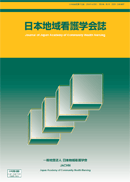Volume 25, Issue 2
Displaying 1-5 of 5 articles from this issue
- |<
- <
- 1
- >
- >|
Research Reports
-
2022Volume 25Issue 2 Pages 4-12
Published: 2022
Released on J-STAGE: August 25, 2022
Download PDF (1205K) -
2022Volume 25Issue 2 Pages 13-22
Published: 2022
Released on J-STAGE: August 25, 2022
Download PDF (1223K) -
2022Volume 25Issue 2 Pages 23-31
Published: 2022
Released on J-STAGE: August 25, 2022
Download PDF (1220K)
Community Health Nursing Report
-
2022Volume 25Issue 2 Pages 32-39
Published: 2022
Released on J-STAGE: August 25, 2022
Download PDF (1146K)
Information
-
2022Volume 25Issue 2 Pages 40-47
Published: 2022
Released on J-STAGE: August 25, 2022
Download PDF (1146K)
- |<
- <
- 1
- >
- >|
